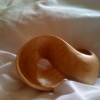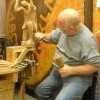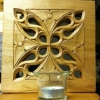Tool rolls are used for transporting carving tools; there are good reasons not to work out of them.
And, there's a right and wrong way of using them. You didn't know?
Well, allow me to show you...
You can read a lot more about storing woodcarving tools in my book: Woodcarving Tools, Materials & Equipment, which you can get here:

| 15 September 2020 11:18
Chris: Thanks for the swift and comprehensive answer(s). Book on order !
Kind regards
David

| 15 September 2020 09:04
David - Thanks for that question; and apologies: I needed to update the details of my book for this video, which I have now done.
Originally I wrote ONE volume, then it was republished as two; now it is republished as a single volume again by Echo. It is readily available from Amazon, Barnes & Noble etc; I've added links above too.
I think this book supplements what we have on this site but, honestly, if a picture is worth a thousand words (and what of a moving picture?) you can't get better than watching me, other than sharing a bench... What I like about the book - any book - is the way you can flip through and browse and have a different sort of picture or understanding of what we are doing and what we need.
Back to your original question: I use metal cabinets with drawers (taking A4 sort of size) and yes, I've lined the bottoms of each drawer with cork (Stick-on tiles). Also the front inside edge of the drawer to protect the cutting edges.

| 14 September 2020 08:37
Chris
Could you say a little more about tool storage please ? I note that you say that you keep (most of) your tools in drawers but I can't find any reference to this anywhere. For example, wood or metal drawers, lined or unlined . all facing same way or not etc. Is this covered in the book you mention ?
But that leads to other questions ! ? I can only find WTM&E Vol 1 as 2nd hand (and no sign of a Vol2) but there does seem to be a 2020 book published by Echo Point which is a 'print on demand' and is 'Woodcarving' with a subtitle of 'Tools and Equipment'. Is this the same book ? I've got most of your other books so does this one add to the material in the on line course ?
Sorry to send such a 'barrage' of questions ! Kind regards David

| 08 June 2018 14:31
Gordon - I don't have anything to add myself, I'm afraid, not having that problem. However, I did put "oil to stop tools rusting" into Google and found some interesting information that might be new to you.
Search more there?

| 07 June 2018 05:02
Chris, any recent opinions on how to protect the steel of tools from corrosion? I note that some people get good results with WD40, and that is easy to obtain. I live in Hong Kong, where the humidity is often off the charts, so I need some protection, apart from using dehumidifiers. I note that Veritas suggests the use of silicon-free paste wax, but not sure I can get that here.

| 25 March 2017 15:30
1. Camilla oil comes from woodcarving supply houses, in several sizes. It can be used very sparingly. I also use it on iron planes and tools. Use it very sparingly because not much is needed. It's a tradition protection for Japanese tools, which will rust if you look at them sideways.
2. In contrast, I learned online that a good lubricant for something like saws (and other working tools), is 3-in-1 Oil, or other mechanical oil that will not spontaneously combust. Very important, spontaneous combustion when we oil a tool for storage. Of course, oiling a saw or other tool (such as the sole of a bench plane) to make it cut better gets oil on the wood.
3. Check Google for others that spontaneously combust, including wood stains you might apply with a cloth and motor oils and vegetable oils such as linseed and tung oils used for finishing.
4. At the very least, spread oiled cloths outside to dry before disposal. While there are stories of people spontaneously combusting, my only suggestion is to consult a member of the clergy.

| 27 September 2016 22:43
Thanks for your help...
The only reason I'm am planning on making a box to store some of my tools is because up until now, I have been keeping all my tools in my bench--both when I am and am not using them; I have too many tools now, though, to always keep them all on my bench, so I need a place to put certain ones when I am not using them. I figured that a box (with a lid that is not sealed too tight) would probably be a safer option than a tool roll.
Thanks again!
Liam

| 27 September 2016 14:17
Liam - It's hard to say, really but a sealed box has got to be better than a fabric tool roll?
The best way to prevent your tools getting rusty of course is to use them. But if you are not able to for a period of time, how about keeping the rolls in the house, in a dry environment, and only take them to the workshop when you are carving?

| 26 September 2016 02:04
Hello Mr. Pye,
I do have a tool roll, but since there is a chance of rust, and since the tool roll doesn't have enough pockets for all my carving tools, I figured I would try making a box to hold them. How much moisture do you think would get trapped in a wooden box as opposed to a tool roll?
Thanks,
Liam

| 13 April 2015 10:58
Paul - I think it important that your tool roll 'breathes' so as not to trap moisture in with the blades.That probably means no waterproofing at all then. (If you are carving in the rain I think an umbrella would be better!) I'd get or make yourself another little roll just for your knives. It'll protect them better. Also, if you have a lot of tool rolls, it's a good idea to organise them: keep one for gouges, ones for spoonbents etc

| 25 March 2015 15:08
Thanks for the great video, I just bought a new tool roll and washing it didn't occur to me. I have two questions:
1. It rains here from time to time and it is often rather sudden. I was considering waxing the exterior of my canvas tool roll for a little extra water protection. Is there anything I need to consider when doing this, e.g., will any wax do or do some cause damage/promote corrosion?
2. Is it safe to keep carving knives in the same roll as chisels and gouges? This would certainly be mor convenient for me, but it doesn't seem like the fine carving blades would nestle as well as the gouges, and I don't want to nick or otherwise damage my knives? If these can be put in the roll, are they also placed blade out like the gouges (this seems more dangerous with knives)?

| 27 July 2014 11:53
I have used Camelia oil for years and find it to be excellent for storing tools and preventing rust. It is a traditional oil used in Japan for a very long time and you'll find good discussions about it on the web. It is a thin oil and much less messy to apply than WD40 and cleaner. Most places that sell fine tools also sell Camelia oil.

| 08 January 2014 07:33
Raul - Lucky you! We have a lesson on restoring old gouges coming up this month... Around 20th January.

| 07 January 2014 12:14
Chris, Old gouges that have oxide. Gouges with oxide have been wet... How to clean the gouges?

| 18 November 2013 09:18
Li - Sorry, I have no experience of Camellia oil. Anyone else?

| 14 November 2013 23:00
What about using camellia oil on tools?

| 29 October 2013 18:40
WD-40, abbreviated from the phrase "Water Displacement, 40th formula," was originally designed to repel water and prevent corrosion - maybe that's why it is keeping some people's tools rust free.

| 24 September 2013 20:10
Thanks, Chris. The picture above is for 'general' carving chisels I think. My chisels are the flat letter carving ones, so perhaps the Forge supply a different roll for those. Perhaps they are expecting people to put the blades in first! When I do that the chisels fit very snugly. I will be washing my roll soon! Thanks, David.

| 24 September 2013 18:30
David - It sounds as if your tool roll is too short for the blades, which should nestle between the handles when rolled, and which shouldn't be the case with tools and rolls both bought a la Forge de SJ. It surpeises me since the tool rool in the picture above also accompanied those very tools! Nevertheless, I'll mention this to them when I can.

| 23 September 2013 12:16
Like many others, I put the chisels in the roll, blade-first. I found that if I reversed the chisels, then the sharp tool edge projected from the edge of tool rool. This is using the roll which came with the 7 chisels from Forge De Saint Jeury: http://www.forge-de-saint-juery.com/chris-pye-letter-carving-chisels/. For now, I've put them back in the intuitive way.

| 18 September 2013 20:47
Fine woodworking did a study recently and found that WD40 was one of the best rust-beaters. I forgot which edition it was in.

| 27 August 2013 23:20
Clive - I've never done that - I keep my tools in drawers - and a web search will show quite a few alternative oils - but it seems to work for you! No doubt you wipe any oil or grease off the tools before you use them; you really don't want that on the wood.

| 23 August 2013 11:23
Am I right in spraying my tools with WD40 type oil.. The tool rolls are also sprayed with WD40.. After twenty years of using the rolls all oiled up, I have no tools with rust on them..

| 24 April 2013 18:56
Albert - The traditional way, and still probably the best, is to have different handles; though this does, of course, involve making your own. Next best might be colouring the handles or otherwise marking them with patterns or lines - carved or burnt in. You don't need to mark every tool, only the ones you really need to find quickly.

| 23 April 2013 02:10
Chris - Is there a good way to mark tools so as to better identify them from a distance? (using paint, a burner, marking roll, etc).

| 30 March 2013 17:15
Chris - many thanks for the prompt and thorough response. I've had tools in there for about 12 months and at close inspection yesterday, did notice some corrosion on some of them. I will have to do something about that. Thank you.

| 30 March 2013 07:34
Ian - My concern with any tool roll, and yours too, quite correctly so, is the effect of any dressing or chemicals in the fabric, or leather, on the blade metal; carving tools being high-carbon and not stainless steel are susceptible to damp, acids etc. I cannot answer for any particular product but you'd think such a firm as thoughtful as Lee Valley would have checked their tool roll out in this regard while doing their R&D. You'll find out! Make sure the roll is kept in the dry.

| 29 March 2013 22:20
Very informative. As a beginner, yes, I was doing it wrong. Question. I purchased a leather tool role from Lee Valley. Is there any downside or upside to leather on the tools themselves (corrosion?) that I should know about? Thank you for any responses.

| 25 January 2013 16:15
Gerald, I've stored some of my tools on a magnetic tool holder before and the only problem is that it can magnetize them. Then if you have them too close together while lying on the bench while carving, they can clink together and damage the cutting edge.

| 11 January 2013 15:13
Gerald - I've never stored tools like that but I'm sure you can store tools on magnetic strips or those little button-like ones. I can't imagine the magnets would affect the crystal structure of hardened steel blades in anyway whatsoever. You'd need a Hadron Collider...

| 11 January 2013 02:39
My question is does a magnetic tool holder have an affect on a wood carving tool? Mainly having an affect in the tools ability to hold an edge.

| 22 December 2012 09:15
I'm going to wash my tool rolls today, thanks for the great tip. I also keep blocks of camphor in each tool drawer to help minimize rust. It's an old diemaker's trick; not sure if it really works, but seems to. While I'm on a roll here; I saw a great tip for storing rasps and files in a magazine - wrap them in aluminum foil; it acts as a sacrificial metal and protects the cutting edges from other tools. I haven't used it long, so don't know about the rust protection, but it works very well to keep rasps from getting dull in a drawer- especially if you reuse the foil and it gets a little wrinkly (is that a word?)